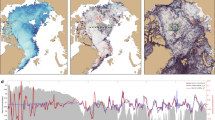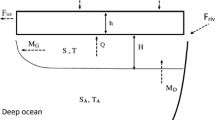Abstract
Sea ice has been suggested, based on simple models, to play an important role in past glacial–interglacial oscillations via the so-called “sea-ice switch” mechanism. An important requirement for this mechanism is that multiple sea-ice extents exist under the same land ice configuration. This hypothesis of multiple sea-ice extents is tested with a state-of-the-art ocean general circulation model coupled to an atmospheric energy–moisture-balance model. The model includes a dynamic-thermodynamic sea-ice module, has a realistic ocean configuration and bathymetry, and is forced by annual mean forcing. Several runs with two different land ice distributions represent present-day and cold-climate conditions. In each case the ocean model is initiated with both ice-free and fully ice-covered states. We find that the present-day runs converge approximately to the same sea-ice state for the northern hemisphere while for the southern hemisphere a difference in sea-ice extent of about three degrees in latitude between the different runs is observed. The cold climate runs lead to meridional sea-ice extents that are different by up to four degrees in latitude in both hemispheres. While approaching the final states, the model exhibits abrupt transitions from extended sea-ice states and weak meridional overturning circulation, to less extended sea ice and stronger meridional overturning circulation, and vice versa. These transitions are linked to temperature changes in the North Atlantic high-latitude deep water. Such abrupt changes may be associated with Dansgaard–Oeschger events, as proposed by previous studies. Although multiple sea ice states have been observed, the difference between these states is not large enough to provide a strong support for the sea-ice-switch mechanism.












Similar content being viewed by others
References
Abbot D, Voigt A, Koll D (2011) The Jormungand global climate state and implications for neoproterozoic glaciations. J Geophys Res 116:D18,103
Adcroft A, Campin JM, Hill C, Marshall J (2004) Implementation of an atmosphere-ocean general circulation model on the expanded spherical cube. Mon Weath Rev 132(12):2845–2863
Alley RB, Meese D, Shuman C, Gow AJ, Taylor K, Grootes P, White J, Ram M, Waddington ED, Mayewski P, Zielinski G (1993) Abrupt increase in Greenland snow accumulation at the end of the Younger Dryas event. Nature 362:527–529
Arzel O, Colin de Verdiére A, England MH (2010) The role of oceanic heat transport and wind-stress forcing in abrupt millennial-scale climate transitions. J Clim 23(9):2233–2256
Arzel O, England MH, Saenko O (2011) The impact of wind-stress feedback on the stability of the Atlantic meridional overturning circulation. J Clim 24:1965–1984
Ashkenazy Y, Tziperman E (2004) Are the 41 kyr glacial oscillations a linear response to Milankovitch forcing? Quat Sci Rev 23(18–19):1879–1890
Ashkenazy Y, Tziperman E (2007) A wind-induced thermohaline circulation hysteresis and millennial variability regimes. J Phys Oceanogr 37(10):2446–2457
Bond G, Heinrich H, Broecker W, Laberie L, McManus J, Andrews J, Huon S, Jantschik R, Clasen S, Simet C, Tedesco K, Klas M, Bonani G, Ivy S (1992) Evidence for massive discharges of icebergs into the North Atlantic Ocean during the last glacial period. Nature 360(6401):245–249
Bryan K (1984) Accelerating the convergence to equilibrium of ocean-climate models. J Phys Oceanogr 14:666–673
Campin JM, Marshall J, Ferreira D (2008) Sea-ice ocean coupling using a rescaled vertical coordinate z*. Ocean Model 24(1–2):1–14
Colin de Verdiére A, Te Raa L (2010) Weak oceanic heat transport as a cause of the instability of glacial climates. Clim Dyn 35(7–8):1237–1256
Dansgaard W, White J, Johnsen S (1989) The abrupt termination of the Younger Dryas climate event. Nature 339:532–534
Eisenman I, Wettlaufer J (2009) Nonlinear threshold behavior during the loss of Arctic sea ice. Proc Natl Acad Sci USA 106:28–32
EPICA-Community-Members (2004) Eight glacial cycles from an antarctic ice core. Nat Biotechnol 429:623–628
Fanning AF, Weaver AJ (1996) An atmospheric energy-moisture balance model: climatology and interpentadal climate change, and coupling to an OGCM. J Geophys Res 101(D10):15111–15125
Ferreira D, Marshall J, Rose BEJ (2011) Climate determinism revisited: multiple equilibria in a complex climate model. J Clim 24:992–1012
Gent PR, McWilliams JC (1990) Isopycnal mixing in ocean circulation models. J Phys Oceanogr 20(1):150–155
Ghil M (1994) Cryothermodynamics: the chaotic dynamics of paleoclimate. Physica D 77:130–159
Gildor H (2003) When Earth’s freezer door is left ajar. EOS 84(23):215
Gildor H, Tziperman E (2000) Sea ice as the glacial cycles climate switch: role of seasonal and orbital forcing. Paleoceanography 15:605–615
Gildor H, Tziperman E (2001) Physical mechanisms behind biogeochemical glacial-interglacial CO 2 variations. Geophys Res Lett 28:2421–2424
Gildor H, Tziperman E (2003) Sea-ice switches and abrupt climate change. Philos Trans R Soc London Ser A Math Phys Eng Sci 361(1810):1935–1942
Heinrich H (1988) Origin and consequences of cyclic ice rafting in the Northeast Atlantic Ocean during the past 130,000 years. Quat Res 29:142–152
Hibler WD (1980) Modeling a variable thickness sea ice cover. Mon Weath Rev 108:1943–1973
Holland MM, Bitz CM, Hunke EC, Lipscomb WH, Schramm JL (2006a) Influence of the sea ice thickness distribution on polar climate in CCSM3. J Clim 19(11):2398–2414
Holland MM, CM Bitz, Tremblay B (2006b) Future abrupt reductions in the summer Arctic sea ice. Geophys Res Lett 33:L23,503
Imbrie J, Hays J, Martinson D, McIntyre A, Mix A, Morley J, Pisias N, Prell W, Shackleton N (1984) The orbital theory of pleistocene climate: support from a revised chronology of the marine δ18 O record. In: Berger A, Imbrie J, Hays J, Kukla G, Saltzman B (eds) Milankovitch and climate, Part I, D. Reidel, Dordrecht, pp 269–305
Kaspi Y, Sayag R, Tziperman E (2004) A “triple sea-ice state” mechanism for the abrupt warming and synchronous ice sheet collapses during Heinrich events. Paleoceanography 19(3):PA3004. doi:10.1029/2004PA001009
Langen PL, Alexeev VA (2004) Multiple equilibria and asymmetric climates in the ccm3 coupled to an oceanic mixed layer with thermodynamic sea ice. Geophys Res Lett 31:L04201
Large WG, Mcwilliams JC, Doney SC (1994) Oceanic vertical mixing: a review and a model with a nonlocal boundary-layer parameterization. Rev Geophys 32(4):363–403
Lenton TM, Held H, Kriegler E, Hall JW, Lucht W, Rahmstorf S, Schellnhuber HJ (2008) Tipping elements in the Earth’s climate system. Proc Natl Acad Sci USA 105:1786–1793
Levitus SE (1982) Climatological atlas of the world ocean. NOAA Professional Paper 13 US Government Printing Office, Washington, DC
Li C, Battisti D, Schrag D, Tziperman E (2005) Abrupt climate shifts in Greenland due to displacements of the sea ice edge. Geophys Res Lett 32:L19702
Lindsay RW, Zhang J (2005) The thinning of arctic sea ice, 1988 2003: have we passed a tipping point?. J Clim 18:4879–4894
Losch M, Menemenlis D, Heimbach P, Campin JM, Hill C (2010) On the formulation of sea-ice models. part 1: effects of different solver implementations and parameterizations. Ocean Model 33:129–144
Loving JL, Vallis GK (2005) Mechanisms for climate variability during glacial and interglacial periods. Paleoceanography 20(4):PA4024
Manabe S, Stouffer RJ (1999) The role of the thermohaline circulation in climate. Tellus 51:91–109
Marotzke J, Botzet M (2007) Present-day and ice-covered equilibrium states in a comprehensive climate model. Geophys Res Lett 34:L16704
Marshall J, Adcroft A, Hill C, Perelman L, Heisey C (1997a) A finite-volume, incompressible Navier stokes model for studies of the ocean on parallel computers. J Geophys Res 102, C3:5753–5766
Marshall J, Hill C, Perelman L, Adcroft A (1997b) Hydrostatic, quasi-hydrostatic, and nonhydrostatic ocean modeling. J Geophys Res 102(C3):5733–5752
Maslanik JA, Fowler C, Stroeve J, Drobot S, Zwally J, Yi D, Emery W (2007) A younger, thinner Arctic ice cover: Increased potential for rapid, extensive sea-ice loss. Geophys Res Lett 34:L24501
Merryfield WJ, Holland MM, Monahan AH (2008) Multiple equilibria and abrupt transitions in Arctic summer sea ice extent. In: DeWeaver E, Bitz CM, Tremblay B (eds) Arctic sea ice decline: observations, projections, mechanisms, and implications. Geophysical Monograph Series, vol 180. AGU, Washington, D.C., pp 151–174
MITgcm Group (2010) MITgcm user manual. Online documentation, MIT/EAPS, Cambridge, MA 02139, USA, http://mitgcm.org/public/r2_manual/latest/online_documents/manual.html
Mix AC, Bard E, Schneider R (2001) Environmental processes of the ice age: land, oceans, glaciers (EPILOG). Quat Sci Rev 20:627–657
Overpeck JT, Strum M, Francis JA, Perovich DK, Serreze MC, Benner R, Carmack EC, Chapin FS, Gerlach SC, Hamilton LC, Hinzman LD, Holland M, Huntington HP, Key JR, Lloyd AH, McDonald GM, McFadden J, Noone D, Prowse TD, Schlosser P, Vörösmarty C (2005) Arctic system on trajectory to new, seasonally ice-free state. EOS Trans Am Geophys Union 86(34):309–313
Peltier WR (1994) Ice age paleotopography. Science 265:195–201
Petit JR, Jouzel J, Raynaud D, Barkov NI, Barnola JM, Basile I, Bender M, Chappellaz J, Davis M, Delaygue G, Delmotte M, Kotlyakov VM, Legrand M, Lipenkov VY, Lorius C, Pepin L, Ritz C, Saltzman E, Stievenard M (1999) Climate and atmospheric history of the past 420,000 years from the Vostok ice core, Antarctica. Nature 399:429–436
Ram M, Koenig G (1997) Continuous dust concentration profile of pre Holocene ice from the Greenland ice sheet project 2 ice core: dust stadials, interstadials, and the Eemian. J Geophys Res 102:26641–26648
Redi MH (1982) Oceanic isopycnal mixing by coordinate rotation. J Phys Oceanogr 12:1154–1158
Sayag R, Tziperman E, Ghil M (2004) Rapid switch-like sea ice growth and land ice–sea ice hysteresis. Paleoceanography 19:PA1021. doi:10.1029/2003PA000946
Schmittner A, Meissner KJ, Eby M, Weaver AJ (2003) Forcing of the deep ocean circulation in simulations of the last glacial maximum. Paleoceanography 17(2):1015
Semtner AJ (1976) A model for the thermodynamic growth of sea ice in numerical investigations of climate. J Phys Oceanogr 6
Serreze MC, Francis JA (2006) The Arctic amplication debate. Clim Change 76:241–264
Tietsche S, Notz D, Jungclaus JH, Marotzke J (2011) Recovery mechanisms of Arctic summer sea ice. Geophys Res Lett 38:L02707
Timmermann A, Gildor H, Schulz M, Tziperman E (2003) Coherent resonant millennial-scale climate oscillations triggered by glacial meltwater pulses. J Clim 16:2569–2585
Tziperman E, Gildor H (2003) The mid-Pleistocene climate transition and the source of asymmetry between glaciation and deglaciation times. Paleoceanography 18(1). doi:10.1029/2001PA000627
Tziperman E, Raymo M, Huybers P, Wunsch C (2006) Consequences of pacing the Pleistocene 100 kyr ice ages by nonlinear phase locking to Milankovitch forcing. Paleoceanography 21:PA4206. doi:10.1029/2005PA001,241
Wang Z, Mysak L (2006) Glacial abrupt climate changes and Dansgaard–Oeschger oscillations in a coupled climate model. Paleoceanography 21(2):PA2001
Weaver AJ, Eby M, Wiebe EC, Bitz CM, Duffy PB, Ewen TL, A F Fanning MMH, MacFadyen A, HD Matthews KM, Saenko O, Schmittner A, Wang H, Yoshimori M (2001) The UVic earth system climate model: model description, climatology and application to past, present and future climates. Atmos Ocean 39:361–428
Winton M (1993) Deep decoupling oscillations of the oceanic thermohaline circulation. In: Peltier WR (ed), Ice in the climate system, NATO ASI series I: global environmental, change, vol 12, Springer, Berlin, pp 417–432
Winton M, Sarachik ES (1993) Thermohaline oscillation induced by strong steady salinity forcing of ocean general circulation models. J Phys Oceanogr 23:1389–1410
Wunsch C (2003) The spectral description of climate change including the 100 ky energy. Clim Dyn 20:353–363. doi:10.1007/s00382-002-0279-z
Acknowledgments
This work was supported by the Israel-US Binational Science foundation. ET was supported by the NSF climate dynamics program, grants ATM-0754332 and ATM-0902844 and thanks the Weizmann institute for its hospitality during parts of this work. We thank Ian Eisenman for helpful discussions and suggestions and André Paul for help with implementing the EMBM.
Author information
Authors and Affiliations
Corresponding author
Rights and permissions
About this article
Cite this article
Ashkenazy, Y., Losch, M., Gildor, H. et al. Multiple sea-ice states and abrupt MOC transitions in a general circulation ocean model. Clim Dyn 40, 1803–1817 (2013). https://doi.org/10.1007/s00382-012-1546-2
Received:
Accepted:
Published:
Issue Date:
DOI: https://doi.org/10.1007/s00382-012-1546-2




